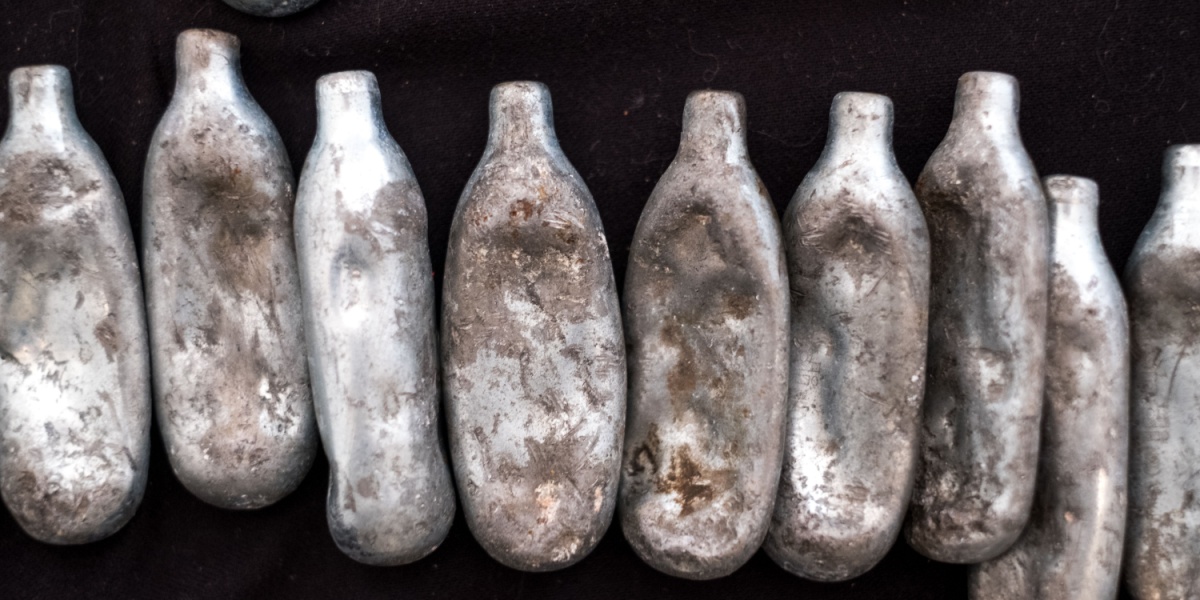Because of their legal status and easy access, inhalants might seem harmless at first. Household products like spray paint, glue, or even whipped cream chargers (or “Galaxy gas”) are easy to find at a local hardware or convenience store and are typically inexpensive to purchase.[1] What many people don’t realize is that inhalant abuse can turn deadly in an instant. This is where Sudden Sniffing Death Syndrome (SSD) can come into play–a phenomenon where even a single use of an inhalant can cause fatal heart failure.
Below, we’ll explore the details of this syndrome, explain how it happens, and address why we would be concerned about inhalant use, particularly among young people.
- Sudden Sniffing Death Syndrome (SSD) is a fatal complication of inhalant use, occurring due to sudden cardiac arrest caused by volatile substances.
- Certain inhalants, including butane, freon, and nitrous oxide, are high-risk for SSD, as they sensitize the heart to adrenaline, triggering fatal arrhythmias.
- Resuscitation from SSD is rarely successful, making awareness, prevention, and immediate CPR the best strategies for reducing inhalant-related deaths.

What is sudden sniffing death syndrome?
Sudden Sniffing Death Syndrome (SSD) is a term used to describe sudden cardiac arrest that occurs as a result of inhaling volatile substances. It can occur after an individual takes a single huff of a product, although it is more common with repetitive use over a short time frame and results in the heart suddenly stopping beating. [2]
SSD is more often linked to inhaling halogenated hydrocarbons, chemicals found in refrigerants, aerosol sprays, and industrial solvents, although it can happen with the use of any inhalant. [3] These substances can cause fatal arrhythmias known as ventricular fibrillation without warning. Aromatics like toluene, found in glue and paint thinners, have also been shown to trigger SSD, although reported cases are rarer. [2]
Unfortunately, resuscitation from SSD is rarely successful, which makes awareness and prevention even more crucial. [2]
How does abusing inhalants cause sudden sniffing death?
Most inhalants exert their effects by depressing the central nervous system, causing a brief but intense high. These substances can also trigger a catastrophic chain reaction in the heart. When inhaled, the chemicals in these products sensitize the cells in the heart to adrenaline, making it more prone to life-threatening arrhythmias. [4] A sudden scare, physical activity, or even standing up too quickly can lead to a fatal cardiac arrest. [2]
In some cases, SSD may also be linked to severe metabolic acidosis, especially when using substances like toluene. Toluene abuse can lead to potassium imbalances, metabolic acidosis, rhabdomyolysis (rapid muscle tissue breakdown), and fatal cardiac events. [2] Unfortunately, by the time symptoms appear, it may be too late for successful intervention.
Types of inhalants linked with SSD
Not all inhalants carry the same risk of SSD, but research has found that some are particularly dangerous when it comes to SSD. The substances typically linked to SSD include:
- Butane and propane: These substances are found in lighters and gas canisters. They pose a high risk of cardiac arrest and have been reported in multiple cases. [5]
- Freon and other refrigerants: Substances found in air conditioners have been linked to causing heart arrhythmias. [6]
- Nitrous oxide (“galaxy gas” or “whippets”): Can lead to sudden oxygen deprivation and cardiac arrest. [7]
- Toluene: This volatile compound is found in glue and paint thinners. It is highly toxic, impacts brain and heart function, and has been linked to multiple deaths from SSD. [2]
Although these are the substances that have been most commonly linked with SSD, all inhalants pose a risk of this deadly condition, so inhalant users must be aware of this lethal repercussion.
Is inhalant abuse still prevalent among young people?
Although the rate of inhalant use has been generally declining in the United States over the past twenty years, inhalants remain one of the most commonly abused substances among adolescents. This is largely because they are legal, easy to access, and inexpensive.
Based on the National Institute on Drug Abuse, around 4% of 8th graders had admitted to using inhalants in the past year. According to research, middle schoolers are at especially high risk because they may not have access to other drugs like alcohol, which can lead to experimentation with other substances. [8]
Unfortunately, a single mistake in using an inhalant can be deadly, as proven by the case of a 19-year-old Dutch teen who went into cardiac arrest and died after inhaling deodorant spray. [9]
Warning signs of sudden sniffing death
Being aware of the warning signs of inhalant abuse and sudden sniffing death can help prevent tragedy. Warning signs of inhalant abuse to be on the lookout for include:
- Dizziness, slurred speech, or confusion
- Chemical smells on breath or clothing
- Frequent nosebleeds or sores around the mouth [8]
If you notice the following signs or symptoms, an individual may be experiencing sudden sniffing death syndrome. It should be treated as a medical emergency, and medical intervention is needed immediately. Signs of SSD include:
- Sudden collapse or unresponsiveness
- Irregular heartbeat or heart palpitations
- Cessation of breathing
Can immediate medical intervention save someone experiencing SSD?
What makes SSD such a dangerous complication of inhalant use is that medical intervention can sometimes save someone from SSD, but not often.
According to research, most resuscitations after SSD are unsuccessful.[2] If they are successful, they often result in permanent brain damage that causes the individual to be unable to regain consciousness or health.
The best chance of survival for an individual experiencing SSD is immediate CPR and defibrillation. Calling 911 is crucial because first responders may need to use advanced cardiac life support, and the faster this begins, the better an individual's chance at survival.[10]
What to do if someone is showing signs of SSD
If you suspect someone is experiencing SSD:
- Call 911 immediately.
- Check for breathing and pulse. If absent, begin CPR. This helps blood continue circulating to vital organs and can save someone's life.
- Use an AED (Automated External Defibrillator) if available. When placed on the individual, the machine will provide instructions on how to assist them.
- Stay with the person until medical help arrives.
Even if they regain consciousness, they still need medical evaluation, as inhalants can cause long-term damage, and they are still at risk of a cardiac event.
Conclusion
Inhalants are often overlooked as dangerous drugs, but Sudden Sniffing Death Syndrome is proof that even one-time use can be fatal. Spreading awareness and recognizing the signs of inhalant abuse could save lives.
If you or someone you know is struggling with inhalant abuse, help is available. Resources like NIDA and local addiction support groups can guide how to start on the path toward recovery from inhalant abuse.[8]
We encourage you to have the conversation, offer support, and seek professional help when needed.



-guide-detail.jpg?v=1756808798)
-guide-detail.jpg?v=1722502670)